ISSN: 1204-5357
ISSN: 1204-5357
| Anil Kumar Research Scholar, ABV-Indian Institute of Information Technology & Management, Gwalior (M.P.)-474010, India Postal Address: Room No.116, C-Block, ABV-Indian Institute of Information Technology & Management, Morena Link Road, Gwalior (M.P.)-474010, India Author's Personal/Organizational Website: www.iiitm.ac.in Email: anilror@gmail.com |
| M.Sc (Mathematics), M.B.A (Marketing) with 2 years of teaching experience and presently pursuing fulltime Ph.D. in the area of Optimization modeling on consumer buying behaviour at ABV-IIITM, Gwalior. |
| Manoj Kumar Dash Assistant Professor, ABV-Indian Institute of Information Technology & Management Postal Address: Room No.116, C-Block, ABV-Indian Institute of Information Technology & Management , Morena Link Road, Gwalior (M.P.)-474010, India Author's Personal/Organizational Website: www.iiitm.ac.in/?q=users/monajdash Email: manojdash@iiitm.ac.in |
| Dr. Manoj Kumar Dash earned his M.A., M.Phil., Ph.D. and M.B.A. in Marketing from Berhampur University, Berhampur (Orissa) and also qualified UGC-NET. He published more than 53 research paper in various journals of International and National repute. He is the author of three books titled ‘Managerial Economics’, ‘Applied Demand Analysis’ and "Think New-Think Better: A case study of Entrepreneurship" and edited five books. He was involved as Chair Member in conducted International Conference of Arts and Science held at Harvard University, Boston (USA). He conducted 18 faculty development pogramme sponsored by AICTE, MHRD(India) on Multivariate analysis, Econometrics, Research Methodology, etc. His areas of research are: Consumer Behavior, Service Marketing, Productivity and Service Quality, Marketing of Financial Product and Service. |
Visit for more related articles at Journal of Internet Banking and Commerce
The aim of this paper is to construct a measure in service quality for Indian banks and establishes a causal relationship of service attributes performance with customer satisfaction. The SERVQUAL model is used. The quantification of service quality led to the attempt to construct an index. The index is constructed using Structural Equation Modeling (SEM) and American Customer Satisfaction Index (ACSI) as the underlying frameworks. The analysis is based on data of 200 bank customers from the Delhi-NCR. An adapted ACSI is enhanced and improved to accommodate two exogenous constructs. The results indicate that service quality variables are important antecedents of customer satisfaction and retention. These antecedents of service quality have a positive significantly relationship with customer satisfaction. The study concludes with an analysis of how different dimensions of service quality performance attribute impact on customer satisfaction and retention. Such a framework should provide valuable insights to the bank manager to identify key service performance indicators and to design more effective and efficient marketing and management strategies to satisfy their customer.
Keywords |
| SERVQUAL, American Customer Satisfaction Index (ACSI), Customer Satisfaction |
INTRODUCTION |
| Customers are considered as the key for any business survival whether in the businessto- business (B2B) or Business to Customer (B2C). As the most developed economies are now service, rather than product-oriented. Service quality holds a prominent position in the marketing and management point of view (Chau and Kao, 2009). Service quality has been revealed as a key factor in search for sustainable competitive advantage, differentiation and excellence in the service sector (Jabnoun and Al Rasasi, 2005 Jun et al., 1998). Many quality management scholars, such as Parasuraman, Zeithmal and Berry (1985), Parasuraman, Zeithmal and Berry (1988), Jabnoun and Al Rasasi (2005) and Jun, Peterson and Zsidisin (1988) interpret service quality as a multidimensional concept where it is often related to delivering products that meet five generic quality features: reliability, responsiveness, tangibility, assurance and empathy. |
| The manner banks delivered their products and services would define their success within the industry. As products and customer services within the banking industry become more and more similar and substitutable, switching costs of customers are lower and affordable. The competitive nature within the industry has become more challenging these days. Within an intense competitive industry “the bank that has the largest customer base and the highest customer retention rate will be a market leader in the industry” (Khong & Richardson, 2001). With appropriate customer relationships management (CRM), banks could maximize the profits of each customer base (Best, 2005). In order of acquire success within the industry, banks must compete rigorously using their competitive advantages to differentiate their services. One such competitive advantage would be superior quality in customer services. |
| Therefore, banks delivering quality of services better than their competitors would have greater possibilities of success (Tang & Zairi, 1998). In order to understand the level of the banks service quality, a measurement should be in place. However quantifying service quality was complicated and too subjective. Hence this paper examined the likelihood of such quantification. This was an exploratory paper which aimed to construct a measure for service quality in banks. The scope of the paper excluded the detailed discussion of the theoretical framework based on Parasuraman’s SERVQUAL. As the SERVQUAL was a widely researched model since 1985 by Parasuraman, the literature was brief but concise. The scope of the paper also encompasses the mathematical development of a measure to quantify service quality for Indian Banks. The paper is organized as follows: In Section II lists previous literature studies on service quality. Section III elaborates the used methodology from collection of data to output of data while Sections IV explains the Constructing an Index Service Quality. Section V provides the conclusion. |
LITERATURE REVIEW |
| Service quality was defined as the difference between the dimensions in customers’ perceived service and expectations of service (Parasuraman et al., 1988). This was shown in gap 5 in fig.1. Parasuraman’s SERVQUAL model was perhaps one of the most widely-used frameworks in addressing service quality. |
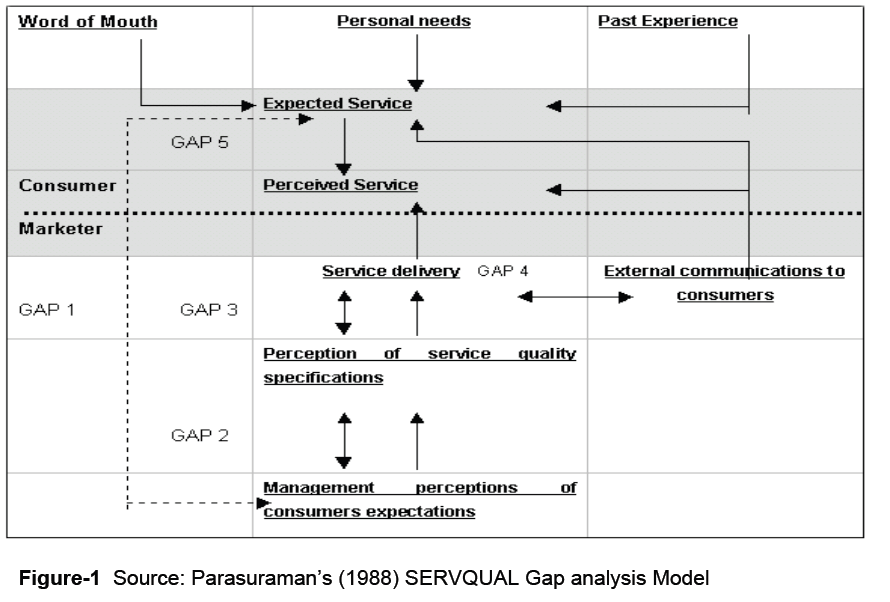 |
| The service gap described in the model highlighted the disparity between the dimensions of expectation and perception in service experience. |
| Customer satisfaction was often related to the experience of consuming a particular product consisting of physical goods and services. When consumption of products fulfilled the needs and wants of consumers, they were likely to feel satisfied and contented. Since the construct in customer satisfaction was latent in nature, the quantification of this construct was complex and complicated in this paper. There were many texts that elucidated the relationship between SERVQUAL and Customer Satisfaction. One such text was from Zeithaml et al. (1993). The augmented SERVQUAL by Zeithaml et al. (1993) illustrated the association between service quality and customer satisfaction. The model also assumed linearity between services attributes to performance with customer satisfaction (Tan & Pawitra, 2001). In this paper, service attributes to performance in banks were defined within the service dimension of Reliability, Responsiveness, Assurance, Empathy and Tangibles. Table1 showed the measurement items (variables) in their respective dimensions that mirrored the service attributes to performance in banks. |
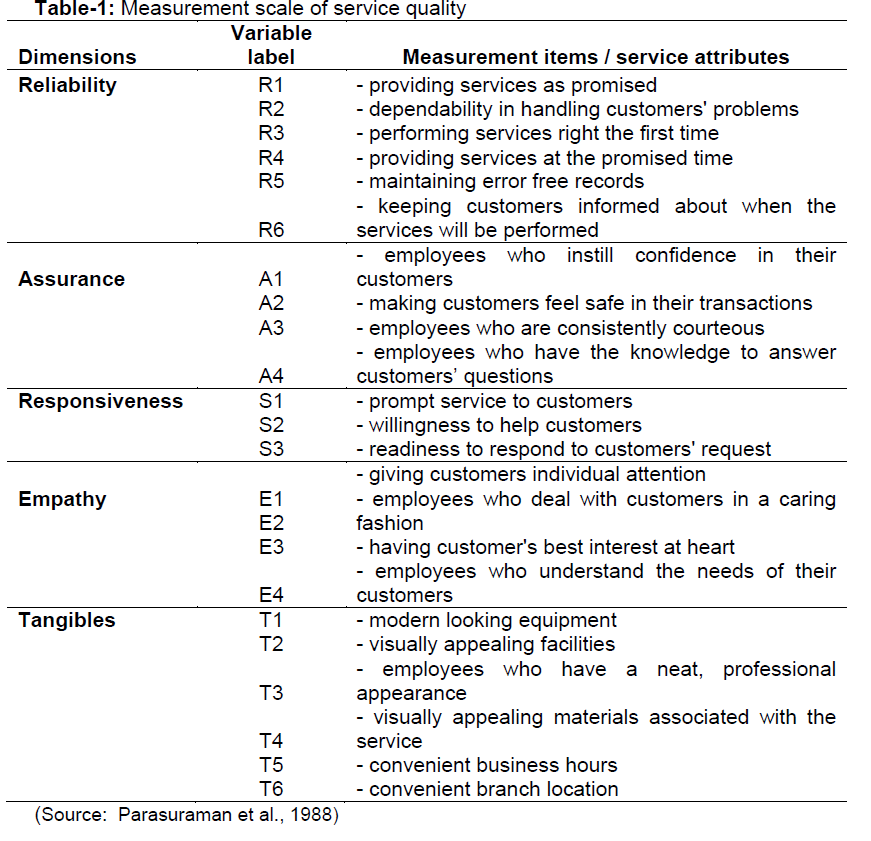 |
| Using the already mentioned linearity assumption, the aim of the paper was elucidated in Figure 2. The figure shows that service attributes to performance in banks was associated with customer satisfaction. |
| The hypothesis implied the following: |
| Hypothesis (H1): Service attributes to performance have positive association with customer satisfaction |
| The strength of association between the independent and dependent dimensions depended on the regression weights established. Since there were multiple independent (23 in total) variables manifesting 5 dimensions, data reduction technique was necessary before estimation of the model. The series of statistical techniques to quantify service quality was explained in the section third of Methodology. |
 |
METHODOLOGY |
| The methodology comprised of two sections, i.e. data collection methodology and data analyses methodology. |
Data Collection Methodology |
| Data collection was done with a survey where structured questionnaire was used for instrument to record opinions of respondents. The questionnaire comprised of questions related to opinions of respondents when experiencing the services of banks. Opinions ranged from expected services, predicted services and perceived services within the 5 dimensions of service quality (see Table 1). The mode of contact with respondents was face-to-face interaction in ten major banks in Delhi- NCR regions. Each Bank was allotted 35 questionnaires. From the 350 questionnaires, 200 questionnaires were completed; a 57.14% response rate. 14 of them were discarded for further analyses due to too many missing values. Although the sample size was unlikely to generalise the population, it was enough for the series of statistical tests (Hair et al., 1998). |
Data Analyses Methodology |
| A series of statistical techniques were required before the quantification of service quality. These statistical analyses were conducted using SPSS 20.0 and AMOS 21.0; widely used statistical software package. The statistical techniques conducted were: (a) Reliability Test (b) Exploratory Factor Analysis (c) Confirmatory Factor Analysis (d) Structural Equation Modeling. |
| (a) Reliability Test (Internal Consistency) :Reliability test, being the most widely used method to measure internal consistency, was conducted on the 23 variables bearing a Cronbach’s alpha of 0.7 and above (Cronbach’s alpha = 0.969).The results inferred the questionnaire was measuring service quality in a meaningful way. The Cronbach alpha coefficients were computed to quantify the scale reliabilities of the factors indentified and to make comparisons in constructs. The Cronbach’s alphas of reliability, assurance, responsiveness, empathy and Tangibles are 0.685, 0.937, 0.972, 0.974, 0.985, and 0.971 respectively. All of these Cronbach’s alphas are > 0.65, higher than the minimum cut off score of 0.60 (Nunnally, 1978), 0.65 (Lee & Kim, 1999), or 0.70 (Nunnally, 1978; Nunnally and Bernstein, 1994).We conclude that all latent variables have adequate reliabilities. |
| (b) Exploratory Factor Analysis (EFA) |
| Exploratory factor analysis is a data reduction technique to examine possible relationships in only the most general form and then allows the multivariate technique to estimate relationships” (Hair et al, 1998,). The objective of Exploratory factor analysis in this paper was to observe the pattern of manifestation of variables on the factors extracted. EFA was extracted using principal component matrix and rotated via Promax. Under the extraction sum of square loading only factor with eign values bigger than 1 was listed. A significant test tells us that the Rmatrix is not an identity matrix; therefore there are some relationships between the variables we hope to include in the analysis. For these data, Bartlett’s test is highly significant (p < 0.001), and therefore factor analysis is appropriate. EFA extracted 2 factors which were not exactly what the literature would have suggested. The convergence of 23 variables into 2 factors was explained in the CFA. Total variance accounted for by the 2 factors was approximately 69%, while none of the items exhibited low factor loadings (< 0.40) or high cross-loadings (> 0.40)The determinant of the correlation matrix was greater than 0.00001 (Field, 2000), therefore was proven that multicollinearity is not a problem for these data. |
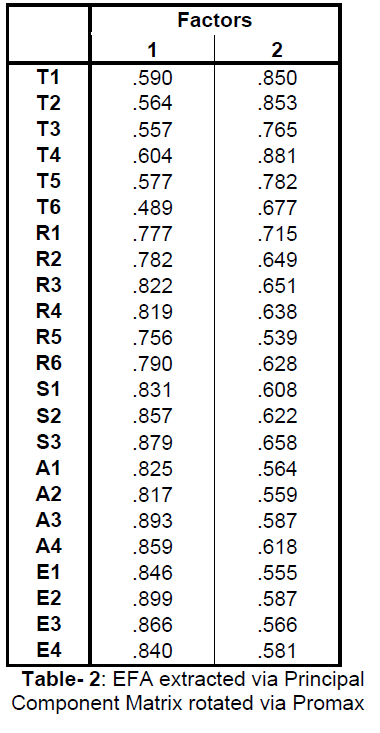 |
| (c) Confirmatory Factor Analysis (CFA) CFA is also known as measurement model. When conducting CFA, variables were assigned to manifest a particular factor, now called a construct, where the manifestation or factor loadings were the highest. When variables had confirmed their manifestation on either constructs based on their highest factor loadings, the service attributes (variables) were manifesting two significant constructs, i.e. Tangibles and Intangibles (see Table 3). The results inferred some consistency with the literature where Construct 1 was a manifestation of service dimension such as Reliability, Assurance, Responsiveness and Empathy while Construct 2 was a manifestation of Tangibles (see Table 1). In order to mathematically notate the measurement models, let the general equation of the measurement models for Construct 1 (Intangibles) and 2 (Tangibles) be given as: |
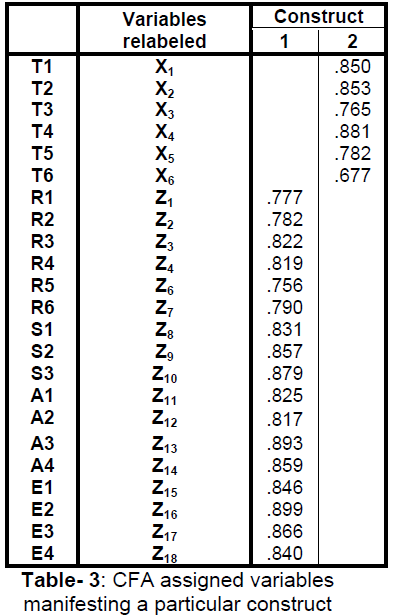 |
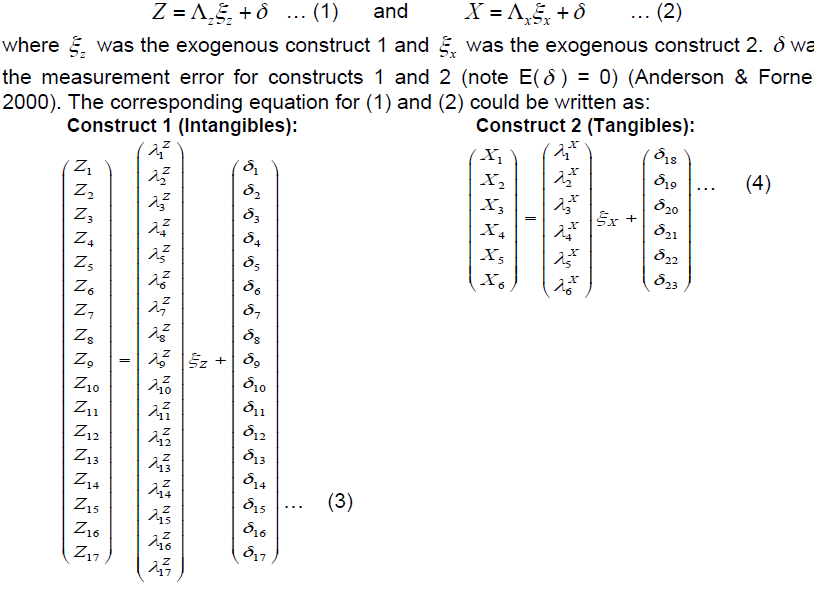 |
| (d) Structural Equation Modeling (SEM) SEM was used to estimate the model (see Figure 3). AMOS 21.0 was used as the statistical software package in the model estimation. The values displayed in the figure were unstandardised estimates. Unstandardised estimates, where the input matrix used was the variance covariance matrix, were used to formulate the equation of the structural model. “When testing a series of causal relationships, covariances were the preferred input matrix type” because this matrix was essential in theory testing (Hair et al., 1998). The underlying assumption of SEM was that the dependence relationships among constructs were assumed to be linear; an assumption similar with the Literature. This assumption meant that Constructs 1 and 2 were linearly associated with customer satisfaction. Constructs 1 and 2 were correlated hence the promax rotation in EFA. |
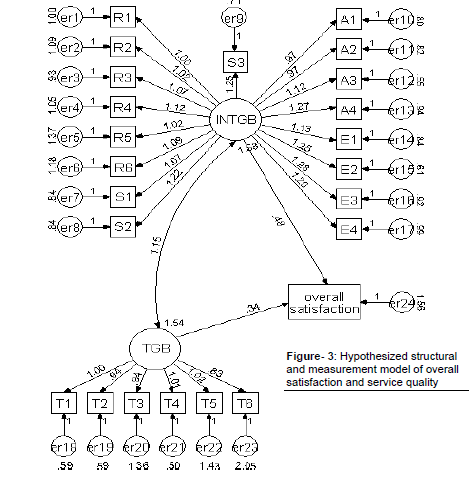 |
| Note: overall satisfaction refers to overall customer satisfaction, INTGB refers to Intangibles (Construct 1), TGB refers to Tangibles (Construct 2), and values shown are unstandardised estimates (variance covariance matrix was used as the input matrix) |
| In order to mathematically notate the structural model, let the general equation of the structural model be given as: |
| where γ z and γ x were the associations between the exogenous constructs 1 & 2 respectively with the criterion customer satisfaction (η ). ζ was the measurement error for customer satisfaction (η ) as shown in Figure 3 (note E (ζ ) = 0, βη = 0) (Anderson & Fornell, 2000). The figure elucidated the dependence relationships specifying the structural and measurement models given in equations (1) and (5). Based on these equations, the structural model would be notated as: |
 |
| In testing the hypothesis proposed earlier, results in table 4 showed there was sufficient evidence to suggest that the service attributes to performance in banks were positively associated with customer satisfaction. This hypothesis test results were in line with the Literature (see Table 4). |
 |
CONSTRUCTING AN INDEX OF SERVICE QUALITY |
| Index is referred to as a scale that reflects a parameter of values ranging from objective to subjective measures relative to a based number. Subjective measures such customer satisfaction, service quality and customer experiences were difficult to quantify. Therefore creating an index based on subjective measures was complicated. Furthermore, construction of an index based on SEM as the underlying statistical framework further complicated the matter. Texts available in the literature that performed such empirical research were limited and scarce. However there was one text by Professor Claes Fornell and his colleagues in their research on American Customer Satisfaction Index (ACSI) (Fornell et al., (1996). Referring to Anderson & Fornell (2000), the ACSI framework was mathematically notated as: |
 |
| where i ws are the unstandardised regression weights and i x s are the manifesting variables. The ACSI was based on an exogenous construct for customer satisfaction, ie customer expectations. Since customer expectations were the only exogenous construct in the model, equation (8) prevailed. To make it short but concise, the ACSI was equated based on a single exogenous construct. Should there be more than one exogenous construct; equation (8) required further extension. The construction of the service quality index was fundamentally based on the framework of ACSI. |
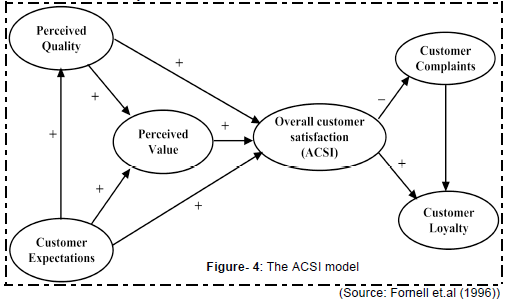 |
| Referring to Figure 3, the structural model of this paper had 2 exogenous constructs. When calculating the index encompassing 2 correlated exogenous constructs, it was crucial to highlight the partial effects of one another on the criterion. The correlation among exogenous constructs effected the multiple correlations (R) on the criterion. As a result, the total variance explained ( R2 ) of the criterion had to be adjusted for R as well. First let this equation be notated as: |
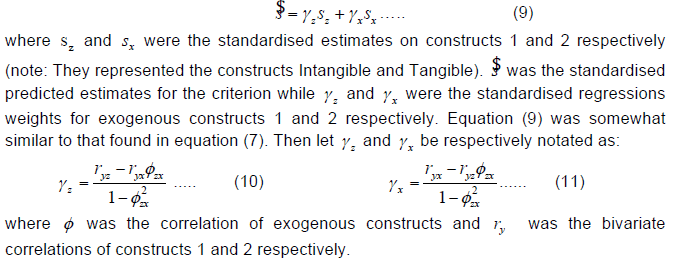 |
| Assuming the R2 of customer satisfaction (criterion) was linearly regressed on the exogenous constructs (see Literature), the degree of changes in service quality would depend of the changes in these constructs. Consequently, the service quality index would also change based on the impact of these exogenous constructs. Therefore let the service quality index be expressed as a function ofΓ , Φ and I . Consequently, let |
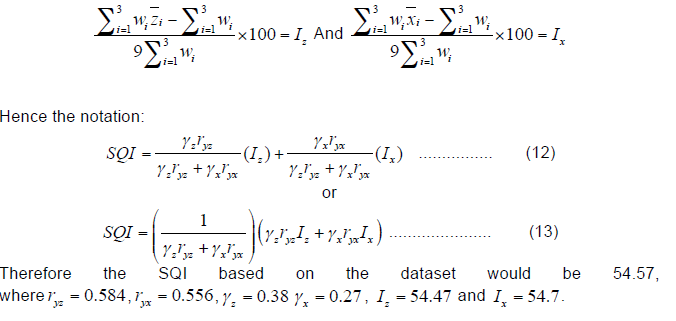 |
DISCUSSION AND CONCLUSION |
| It must be highlighted that the paper did not intend to declare that 54.57 fell short of any expected threshold within the index. The attempt to index was to justify the feasibility in quantifying service quality. The question of whether the index was not up to expectation was left unanswered. However there were several texts indicating the threshold of 0.7 and above. Failing to meet this threshold would mean the service quality was not up to standard. Based on the dataset, the service dimension of intangibles had a higher possibility to improve customer satisfaction. Manifesting variables such as A4, E2, E3, E4, A4 and S2 had the highest multiple correlations stipulating their importance in contributing to higher customer satisfaction. The hypothesis inferred relevance to the literature. It implied that the service attributes to performance had positive association with customer satisfaction. |
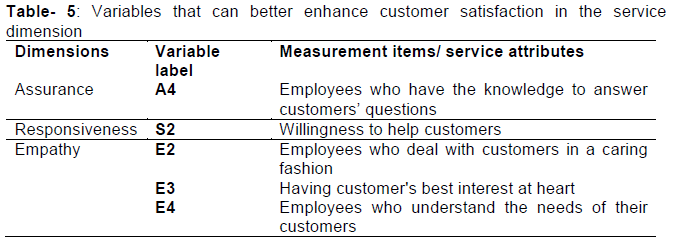 |
| In order to benefit from the service quality index, banks must constantly benchmark their service levels based on their service attributes to performance. From these indices, banks could identify inadequacies in their service quality. With inadequacies established, banks could distinguish essential service attributes that offer the highest possibilities in enhancing the criterion, e.g. customer satisfaction or business performance. The complexity and difficulty of creating an index using SEM and ACSI as the underlying frameworks were displayed in this paper. The index could only handle 2 correlated exogenous constructs at the moment. If there were more than 2 exogenous constructs, the shared impact on the criterion among the constructs could be too complicated. However this was the intention for future research. With more intense identification of service attributes of banks in India, while taking in account the possibility of multiple correlated exogenous constructs, the construction of a service quality index could prove to be a worthwhile effort. Managerially, it is important to understand how to create and offer value for customers so that customer satisfaction and their retention will increase, keep this thing in mind the bank manager to measure the service quality attributes performance timely. Therefore, both in practice and in academic research, customer value has emerged as a critical issue for the successful management of customer relationships. Customer relationships can build if customer is satisfied with the providing services by bank. |
LIMITATIONS AND FURTHER RESEARCH |
| Although this study produces several relevant findings for the management but there are some limitations. First, data of sample (n=200) for this study is collected only few bank from Delhi-NCR, further research can be to test the generalizability of researcher findings. Second, in Delhi-NCR, people are so much busy they don’t have time to give more attention on our researcher that way may be some biasness can be there in our data set. Third, a fundamental limitation of this study is its cross sectional design for further studies some interview can be contacted after taking the proper time from the customer and evaluated the findings given by the researcher. |
ACKNOWLEDGEMENT |
| The authors want to extend their gratitude towards the Editor-in-Chief: Dr. Nikhil Agarwal and anonymous reviewer’s for their indispensable suggestions and comments that improved the quality of the paper significantly. |
References |
|
Copyright © 2025 Research and Reviews, All Rights Reserved